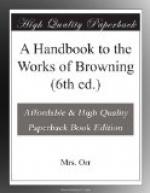The records of this trial contain almost everything of biographical or even dramatic interest in the original book. They are, so far as they go, the complete history of the case; and the result of the trial, ambiguous as it was, supplied the only argument on which an even formal defence of the subsequent murder could be based. The substance of these records appears in full in Mr. Browning’s work; and his readers can judge for themselves whether the letters which were intended to substantiate Pompilia’s guilt, could, even if she had possessed the power of writing, have been written by a woman so young and so uncultured as herself. They will also see that the Count’s plot against his wife was still more deeply laid than the above-mentioned circumstances attest.
Count Guido was of course not satisfied. He wanted a divorce; and he continued to sue for it by means of his brother, the Abate Paul, then residing in Rome; but before long he received news which was destined to change his plans. Pompilia was about to become a mother; and in consideration of her state, she had been removed from the convent to her paternal home, where she was still to be ostensibly a prisoner. The Comparini then occupied a small villa outside one of the city gates. A few months later, in this secluded spot, the Countess Franceschini gave birth to a son, whom her parents lost no time in conveying to a place of concealment and safety. The murder took place a fortnight after this event. I give the rest of the story in an almost literal translation from a contemporary narrative, which was published, immediately after the Count’s execution, in the form of a pamphlet[22]—the then current substitute for a newspaper.
“Being oppressed by various feelings, and stimulated to revenge, now by honour, now by self-interest, yielding to his wicked thoughts, he (Count Guido) devised a plan for killing his wife and her nominal parents; and having enlisted in his enterprise four other ruffians,”—labourers on his property, “started with them from Arezzo, and on Christmas-eve arrived in Rome, and took up his abode at Ponte Milvio, where there was a villa belonging to his brother, and where he concealed himself with his followers till the fitting moment for the execution of his design had arrived. Having therefore watched from thence all the movements of the Comparini family, he proceeded on Thursday, the 2nd of January, at one o’clock of the night,[23] with his companions to the Comparini’s house; and having left Biagio Agostinelli and Domenico Gambasini at the gate, he instructed one of the others to knock at the house-door, which was opened to him on his declaring that he brought a letter from Canon Caponsacchi at Civita Vecchia. The wicked Franceschini, supported by two other of his assassins, instantly threw himself on Violante Comparini, who had opened the door, and flung her dead upon the ground. Pompilia, in this extremity, extinguished the light, thinking thus to elude her




